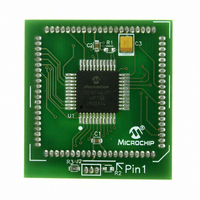MA180023 Microchip Technology, MA180023 Datasheet - Page 144

MA180023
Manufacturer Part Number
MA180023
Description
MODULE PLUG-IN PIC18F46J11 PIM
Manufacturer
Microchip Technology
Series
PIC®r
Datasheet
1.MA180023.pdf
(528 pages)
Specifications of MA180023
Accessory Type
Plug-In Module (PIM) - PIC18F46J11
Tool / Board Applications
General Purpose MCU, MPU, DSP, DSC
Mcu Supported Families
PIC18
Supported Devices
Stand-alone Or W/ HPC(DM183022) Or PIC18(DM183032)
Silicon Manufacturer
Microchip
Core Architecture
PIC
Core Sub-architecture
PIC18
Silicon Core Number
PIC18F
Silicon Family Name
PIC18FxxJxx
Lead Free Status / RoHS Status
Lead free / RoHS Compliant
For Use With/related Products
HPC Explorer Board (DM183022) or PIC18 Explorer Board (DM183032)
For Use With
DM183032 - BOARD EXPLORER PICDEM PIC18DM183022 - BOARD DEMO PIC18FXX22 64/80TQFP
Lead Free Status / RoHS Status
Lead free / RoHS Compliant
Available stocks
Company
Part Number
Manufacturer
Quantity
Price
Company:
Part Number:
MA180023
Manufacturer:
Microchip Technology
Quantity:
135
- Current page: 144 of 528
- Download datasheet (8Mb)
available on a particular device, users can better tailor
PIC18F46J11 FAMILY
9.7
A major challenge in general purpose devices is provid-
ing the largest possible set of peripheral features while
minimizing the conflict of features on I/O pins. The
challenge is even greater on low pin count devices
similar to the PIC18F46J11 family. In an application
that needs to use more than one peripheral multiplexed
on single pin, inconvenient workarounds in application
code or a complete redesign may be the only option.
The Peripheral Pin Select (PPS) feature provides an
alternative to these choices by enabling the user’s
peripheral set selection and their placement on a wide
range of I/O pins. By increasing the pinout options
the microcontroller to their entire application, rather than
trimming the application to fit the device.
The PPS feature operates over a fixed subset of digital
I/O pins. Users may independently map the input and/
or output of any one of the many digital peripherals to
any one of these I/O pins. PPS is performed in software
and generally does not require the device to be
reprogrammed. Hardware safeguards are included that
prevent accidental or spurious changes to the
peripheral mapping once it has been established.
9.7.1
The PPS feature is used with a range of up to 22 pins;
the number of available pins is dependent on the
particular device and its pin count. Pins that support the
PPS feature include the designation “RPn” in their full
pin designation, where “RP” designates a remappable
peripheral and “n” is the remappable pin number. See
Table 1-2 for pinout options in each package offering.
DS39932C-page 144
Peripheral Pin Select (PPS)
AVAILABLE PINS
Priority is given regardless of the type of peripheral that
9.7.2
The peripherals managed by the PPS are all digital
only peripherals. These include general serial commu-
nications (UART and SPI), general purpose timer clock
inputs, timer-related peripherals (input capture and
output compare) and external interrupt inputs. Also
included are the outputs of the comparator module,
since these are discrete digital signals.
The PPS module is not applied to I
tion inputs, RTCC alarm outputs or peripherals with
analog inputs. Additionally, the MSSP1 and EUSART1
modules are not routed through the PPS module.
A key difference between pin select and non-pin select
peripherals is that pin select peripherals are not asso-
ciated with a default I/O pin. The peripheral must
always be assigned to a specific I/O pin before it can be
used. In contrast, non PPS peripherals are always
available on a default pin, assuming that the peripheral
is active and not conflicting with another peripheral.
9.7.2.1
When a pin selectable peripheral is active on a given I/O
pin, it takes priority over all other digital I/O and digital
communication peripherals associated with the pin.
is mapped. Pin select peripherals never take priority
over any analog functions associated with the pin.
9.7.3
PPS features are controlled through two sets of Special
Function Registers (SFRs): one to map peripheral
inputs and the other to map outputs. Because they are
separately controlled, a particular peripheral’s input
and output (if the peripheral has both) can be placed on
any selectable function pin without constraint.
The association of a peripheral to a peripheral selectable
pin is handled in two different ways, depending on
whether an input or an output is being mapped.
AVAILABLE PERIPHERALS
CONTROLLING PERIPHERAL PIN
SELECT
Peripheral Pin Select Function
Priority
© 2009 Microchip Technology Inc.
2
C, change notifica-
Related parts for MA180023
Image
Part Number
Description
Manufacturer
Datasheet
Request
R

Part Number:
Description:
Manufacturer:
Microchip Technology Inc.
Datasheet:

Part Number:
Description:
Manufacturer:
Microchip Technology Inc.
Datasheet:

Part Number:
Description:
Manufacturer:
Microchip Technology Inc.
Datasheet:

Part Number:
Description:
Manufacturer:
Microchip Technology Inc.
Datasheet:

Part Number:
Description:
Manufacturer:
Microchip Technology Inc.
Datasheet:

Part Number:
Description:
Manufacturer:
Microchip Technology Inc.
Datasheet:

Part Number:
Description:
Manufacturer:
Microchip Technology Inc.
Datasheet:

Part Number:
Description:
Manufacturer:
Microchip Technology Inc.
Datasheet:











